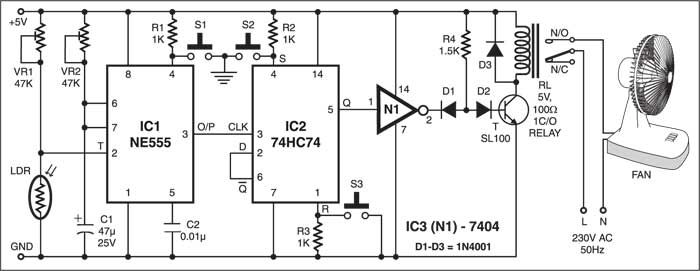 This circuit lets you turn on/off a fan by just directing torchlight or other light toward its light-dependent resistor (LDR). The circuit is powered by a 5V power supply.
This circuit lets you turn on/off a fan by just directing torchlight or other light toward its light-dependent resistor (LDR). The circuit is powered by a 5V power supply.
Circuit Explanation:
Preset VR1 and a light-dependent resistor (LDR) work as the potential divider. Normally, the LDR’s resistance is high (20 kilo-ohms) in darkness and low (2 kilo-ohms) in light. This value of high and low resistances varies for other LDRs. Preset VR1 is used for setting the intensity of light, while preset VR2 is used for setting the output time period of IC1.
When light falls on the LDR, the monostable (IC1) triggers at pin 2, making its output at pin 3 from low to high. This low-to-high transition forms a clock for D flip-flop. The D flip-flop is operated in toggle mode by connecting its Q output to D point. The flip-flop output goes to an inverter (N1). The inverter output is fed to the relay driver transistor.

When the inverter output is low, diode D1 conducts and the current is diverted into the inverter. Hence the relay does not energise. When the inverter output is high, diode D2 conducts and the current is diverted into transistor T. Hence the relay energises.
One terminal of the fan is connected to the normally-open (N/O) contact of the relay, while another terminal is connected to the neutral (N) of mains. The mains live (L) is connected to the pole of the relay. When the relay energises, the fan turns on. Otherwise, the fan remains off.
Switches S1 and S3 are for initial resetting of the monostable (IC1) and D flip-flop (IC2), respectively, and switch S2 is used for setting the D flip-flop. Paste a piece of paper on the face of the LDR so that it doesn’t get activated by ambient light. Use a torch to light the LDR.
After initial resetting of the monostable and D flip-flop, the inverter output goes high and the fan turns on via the relay. When light falls on the LDR, the fan goes off. If torchlight is again directed toward the LDR, the fan turns on. The sequence repeats.
Initially if switch S2 is used to set the D flip-flop, the fan is held ‘off’. The relay does not energise as the Q output of D flip-flop goes high to make the inverter output low. Directing the light towards the LDR at this moment turns the fan ‘on.’
This article is a part of the Top 10 LDR-based Electronics Projects. If you want to read more projects based on LDRs can go through this article.
This Fan on/off Control by Light Circuit was first published in Dec 2003. If you have any suggestions regarding the modification of this circuit, please write to us at [email protected].








This looks very cool to build, I was wondering if you could email me about some details.
thanks